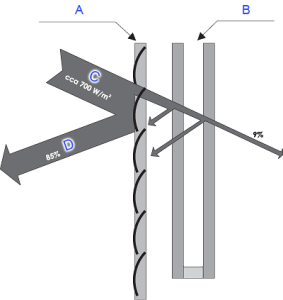Assessing the impact of window blinds on levels of heat gain through windows
In the summer period, heat gains occur in internal spaces; we can divide such gains into two groups by their origin.

- heat gains from internal sources of heat
- heat gains from the external environment
A – EXTERNAL BLINDS – SLATS 45° LIGHT
B – DOUBLE GLAZING
C – SUN’S RADIATION
D – REFLECTION
Sources of heat produce thermal energy causing a direct increase in the air temperature in the form of thermal load by noticeable heat. People, some production processes and air produce or contain water vapour (moisture) that absorbs some heat, thereby creating thermal load by absorbed heat.
Internal sources of heat include the production of heat by people, light fittings, machines, heat passage from neighbouring rooms, or heat gains from production technology.
Heat gains from the external environment consist of heat flows entering due to the passage of solar radiation through structures such as walls, ceilings, the glazed surfaces of windows, doors and through the infiltration of external air.
Heat gains from the external environment, especially heat gains from exposure to the sun, have a decisive impact on the thermal load of buildings – the impact of these gains increases proportionally to the amount of glazed surfaces on a building. Windows, their design, orientation to points of the compass and shading have a considerable impact on heat comfort in a building. Therefore, it is necessary to pay extraordinary attention to these parts of the building.
Heat flow through windows has two elements – heat passage by convention and heat passage by solar radiation. Heat passage by convention, the volume of which depends on the window surface and the heat passage coefficient (the higher the quality of glazing, the lower the coefficient), is negligible in the case of exposure to the sun. A considerable part of heat flow through windows thus consists of heat passage by the sun’s radiation, the value of which depends mainly on the window surface exposed to the sun and on the value of the shading coefficient “s”. The shading coefficient expresses what percentage of radiation passes through the monitored window in comparison with a standard single-glazed window. The value of the shading coefficient “s” depends on the type of glazing and type of shading equipment used. When combining several methods of shading, the value of the shading coefficient “s” is calculated by multiplying the partial values, i.e.
s = s1 x s2 x ….. x sn
The following table shows the values of shading coefficients for various glazing
| Type of glazing | s | Shading equipment | s |
| single glazing | 1,00 |
internal blinds |
0,56 |
| double glazing | 0,90 | ||
|
single dethermal glazing |
0,70 |
internal blinds |
0,65 |
| external dethermal internal standard |
0,60 |
internal blinds |
0,75 |
| reflective single glazing average quality |
0,70 |
external blinds |
0,15 |
| reflective double glazing top quality products |
0,24 |
external blinds, slats 45º |
0,13 |
| external reflective glazing of average quality internal common |
0,60 |
external awnings |
0,30 |
| double reflective glazing good quality |
0,30 |
inter-window blinds, |
0,50 |
| coloured glazing light | 0,80 |
reflective curtains light, external reflective layer |
0,60 |
| coloured glazing medium | 0,70 |
cotton drapery, artificial fibres |
0,80 |
| reflective foil dark | 0,25 | cotton drapery, artificial fibres | 0,80 |
| reflective foil light | 0,42 |
reflective curtains dark, |
0,70 |
| glass with wire insert | 0,80 |
It follows from the table above that e.g. the use of light-coloured external blinds will result in a decrease in heat passage by radiation of approx. 85% compared to the value of heat passage by radiation through the same window without any shading equipment. However, the amount of decrease in the internal temperature of the space cannot be unambiguously determined by calculation – this value can only be ascertained by measuring the internal temperature before and after installation of shading equipment.
Used literature:
1. CSN 73 0548 Calculation of thermal load of air-conditioned areas. Effective from 19862. J. Chyský, K. Hemzal et al.: Technický průvodce, Volume 31 – Větrání a klimatizace, Prague 1993